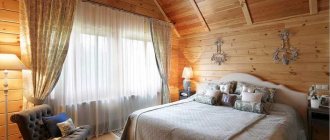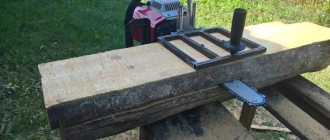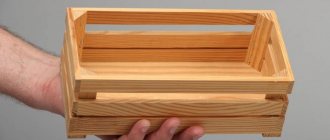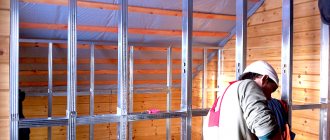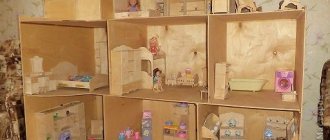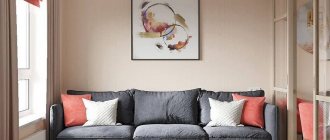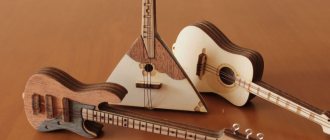A wooden box is a simple but very functional item. Depending on the shape and depth, such products can be used to receive correspondence, grow seedlings at home, or store children's toys or tools.
The design is quite simple, so wooden flower boxes can be made with your own hands. If you use your imagination and apply a little skill, even such an elementary thing can be turned into a real work of art.
What is decoupage?
Decoupage is a technique for decorating a surface using a cut-out design or ornament. The design is glued to the surface of the object and secured with a layer of transparent varnish. Paper decorative elements are most often used. For gluing complex surfaces, it is more convenient to use napkins; they are much thinner than paper, so they stick more easily to the curves of the surface.
The first mention of decoupage dates back to the 15th century. Chinese craftsmen used pictures to decorate furniture. Later, in the 17th century, this technique began to be actively used by Europeans, when furniture from Asian countries came into fashion. Skilled craftsmen glued pictures to the furniture and covered the surface with 30 layers of varnish.
Decoupage in the modern world is represented not only by the decoration of hard surfaces, but also by the processing of fabrics and leather. Decoupage is used in various directions and styles, but most often this technique is typical for pieces of furniture and accessories made in a classic style.
Entertainment complex for cats
An entertainment complex for cats is created from boxes and metal pipes. As you know, tailed animals get bored in apartments. To prevent the animal from damaging furniture and wallpaper, you can occupy it with your own miniature cottage, where cats sleep, play and sharpen their claws. Some boxes are covered with plywood lids with round entry holes, others are left with only the bottoms, which are covered with soft foam rubber and upholstered with fabric, and on others, scratching posts are attached. The modules are connected to each other in any order. Additionally, the “house” is equipped with a ladder system to make it more convenient for the animal to move around the “floors”. Instead of a purchased bed for a cat or dog, cribs are created from a box. The box is thoroughly sanded. It is better not to coat it with varnish, as your pet may not like its smell. Then a pair of upper slats are cut off from one of the sidewalls, which will be the front one. The inside of the box is filled with foam rubber or other soft material and covered with a blanket on top. Additionally, the sleeping place is decorated with miniature hand-sewn pillows. Of course, the size of the box and the future crib is selected according to the dimensions of the pet. To make a feeder, you will need a stainless steel bowl, a wooden container and plywood. The top cover is cut out from the last sheet. Make a round hole in the center for the bowl. The plywood is then secured to the box. All that remains is to insert the bowl. You need to choose one with protruding sides, which will hold the container by the lid. The bowl can be easily removed to wash or replace with another. A double feeder is made from a large box using the same technology with paired containers for food and water.
Decoupage on wood for beginners
If this is your first time trying to create work using the decoupage technique, then take an object with clear and even edges. Decorating such surfaces is much easier compared to round or distorted surfaces.
Decoupage of wooden boxes for beginners will be more accessible when using drawings on thick paper. They're easier to stick to a surface, so you're much less likely to ruin the image. The drawing must be made using water-insoluble paints. Otherwise, when processing with glue, the pattern may flow and become smeared.
Don't choose overly complex compositions. Cut out the image carefully, paying attention to small elements. The more detailed you cut out the picture, the more interesting and attractive it will look in the final version. If the picture has a suitable background, then it is better not to use scissors to create the template. It is enough just to tear the picture along the contour so that the edges remain torn. This way the image will fit better into the design of the item.
Shelving
Wooden boxes make excellent shelving units. They can be strictly rectangular in shape or have asymmetrical edges, which will add a special flavor to the decor of the room. This storage system is ideal for a home workshop, office or living room. The boxes are secured to each other using self-tapping screws or self-tapping screws, painted and placed against the wall. You can store whatever your heart desires on such racks: books, things, jewelry, food, towels and pillows, household chemicals, small decor. The designs look original, on the shelves of which “necessary” things are placed, alternating with flower pots. Rectangular racks can be assembled from identical boxes, which are arranged in a strict order or vertically and horizontally, but in such a way that a storage system of the correct shape is formed.
Drawers mounted on special legs with spaces between the modules will be an excellent addition to a rustic-style kitchen. They store vegetables (potatoes, onions, carrots), jars of pickles or canned food. It is important that each drawer is secured in its natural position, that is, with the bottom down. Thus, the strength of the cabinet will increase, because the container was originally designed for heavy loads.
Preparing the wooden surface
The surface of the wood must be carefully treated before starting to fix the picture. If there is old paint on the surface, you need to remove it with a scraper. Remove all mechanical impurities.
The entire surface of the object must be sanded. After this, a primer is applied. The primer layer must dry completely. This is followed by another stage of sanding and an additional layer of primer. The surface should be smooth and even.
If there are small cracks or crevices on the surface of the wood, then they need to be filled. Wood putty is suitable for these purposes. If you plan to make an antique item, then all surface imperfections should be left and even emphasis should be placed on them. You can make additional flaws and cracks.
The footwear stand
A shoe cabinet is assembled according to the same principle as a rack of drawers. The only thing worth considering: different heights of sneakers, shoes, ankle boots and winter boots. For the first two, shelves made of drawers located horizontally are suitable, and for tall shoes they are placed vertically. If you make a homemade cabinet from an old container that is unevenly painted, then such an element will complement the hallway in the Provence style.
Decoupage wooden box
The surface of the box must be sanded, paying attention to hard-to-reach places. Apply primer and sand again. After this, apply another coat of primer. To make the whole process clear, before starting work it is better to watch a detailed master class on decoupage of wooden boxes.
When choosing a background color, take into account the color scheme of the image that will be glued to the box. Most often, decoupage of a wooden box in white is used; it looks very aesthetically pleasing and fresh. Apply paint evenly to the surface of the wooden box. After complete drying, apply another coat of paint.
Now you can start creating the composition. Napkins are suitable as a base with an image. When they come into contact with the surface treated with glue, they immediately take the desired shape. You need to attach the napkins carefully. If moved incorrectly, they can tear or bunch up. If the napkin has two layers, then we leave only the layer on which the design is applied. To separate the design, do not use scissors, just carefully tear off the image along the edge. Glue the napkin to the surface of the box using PVA glue, wait until the surface dries. You can use different types of paper materials and even fabric. The method of fixing a pattern on a fabric base is exactly the same as in the case of a paper pattern. After the drawing has dried, treat the entire surface with varnish in several layers.
Plywood structures
Here the material is selected depending on the intended use of the finished product. If the box is intended for correspondence, you can get by with thin plywood. For seedlings or flowers, multilayer sheets impregnated with a waterproof compound are more suitable.
The design is made according to the following scheme:
- make a drawing of the box with dimensions;
- the drawing is transferred to a sheet of plywood;
- parts are cut out according to the markings;
- individual elements are fastened together with self-tapping screws or nails, and the joints are treated with sealant.
Considering that plywood is easy to process, you can make more complex, non-standard country boxes. For example, the joints of the walls should be designed according to the tongue-and-groove principle. If you are making a deep box for storing children's toys, you can attach wheels from an old computer chair to the bottom. Drawers with a sliding top panel look interesting. Here a cover is cut out of a sheet of thin plywood and a groove is cut in the upper part of the walls.
Decoupage flower boxes in retro style
The surface of the box must be sanded and leveled. After this, a layer of white paint is applied. After the paint has dried, sand the surface again. To achieve an aging effect, we use dark-colored paint. Burnt umber color is ideal for this purpose. It is not necessary to apply it evenly; the main part of this layer will be covered.
The dried layer of dark paint must be treated with candle wax. This should be done casually, not over the entire surface. In places where the wax sticks to the surface, there will subsequently be small bald spots, which will give the effect of old age.
The next layer will be the finishing layer. Take a paint that matches the color and cover the entire surface of the box with it. Lightly sand the dry surface so that dark gaps appear in some places. Decoupage of a wooden flower box is best done using pictures that correspond to the plants that will be placed in this container. Now you can start fixing the design and coating the product with varnish.
Bedside tables and tables
From the drawers you can make cabinets, coffee tables and boxes for storing small items instead of plastic or wicker baskets. In the latter case, choose containers with high sides. It is simply sanded, varnished or painted and equipped with paired handles on the sides for ease of movement. Bedside tables are assembled from two drawers connected to each other. They store photographs, watches, phones, magazines and books, and the top cover is used as a shelf for lamps or indoor plants. To create a coffee table you will need:
- Four drawers;
- Plywood sheet;
- Self-tapping screws;
- Wheels (optional).
A square-shaped pallet is cut out of plywood. The width of its edges should correspond to the sum of the length of one box and the height of the other. If desired, you can add small indents of a couple of centimeters. Wheels are first attached to the pallet, and then the boxes are attached in a spiral, that is, the side of the next one rests against the back wall of the previous one. The empty middle is decorated with a flower arrangement, a group of candles or a lamp. This coffee table can be used to decorate your living room or backyard in the summer. It is complemented by sun loungers assembled from pallets or poufs from old tires, decorated with rope.
From miniature boxes you can make decorative boxes for jewelry or boxes for flowers on a holiday table.
Finishing the surface of the box
Several layers of varnish must be applied to create a protective coating that will give the product wear-resistant properties. The photo shows decoupage of a wooden box made using several elements. The varnish must be applied in a thin layer. Applying the next layer is possible only after the previous layer has completely dried.
The choice of varnish depends on the desired properties of the future surface. You can take a glossy varnish, then the surface of the box will be shiny. Matte varnish will create a “rough” surface that will not glare. Tint varnish will change the color of the product. It must be used with caution, since a large number of layers can create a very bright shade, against which the design will be lost.
You can apply the varnish with a small roller. To cover hard-to-reach areas, it is more convenient to use a brush. To ensure that the varnish lays down in an even, thin layer, you can use a spray bottle. If you decide to use this method, take care of the safety of your respiratory system.
Box with roses (stencil)
In this master class, we combined several techniques for decorating a box with our own hands. Let's try to mix styles, textures and techniques. The main theme of this master class is fabric imitation using painting. Since not everyone knows how to draw well, we decided to use a stencil here.
A stencil design is attached, you can choose any one you like.
The master class is simple, even a beginner can handle it.
To work you will need:
- Casket or box.
- Acrylic primer.
- Acrylic paints.
- Tassels.
- Stencil.
- Masking tape.
- Sandpaper.
- Everything that can be useful for decoration: cord, ribbons, lace, braid, and so on.
If the box or blank is made of wood, you may need to sand it with sandpaper and varnish it. This way we will protect the workpiece from swelling.
We wait for it to dry and cover it with acrylic primer.
Dry and sand. Cover the bottom and top corners with masking tape.
We paint all sides of the box with any light acrylic paint. Thus, we make the bottom layer for imitation fabric.
We paint with a brush in a horizontal direction, applying the paint evenly and evenly. Next, let the workpiece dry, sand it with sandpaper and varnish it. We mix our light paint with the same beige paint a shade darker.
Popular articles Cool congratulations on Forgiveness Sunday
The paint should not be too thick, so be sure to wet the brush in water and squeeze it out. Apply it to the side with horizontal strokes.
Then take a sponge or brush and sweep it across the surface in a horizontal direction.
That is, we need to make an imitation of fabric. This will be one direction of our “fabric”. This is what should happen after processing with a sponge or brush:
We needed a layer of varnish to prevent the paint from being absorbed into the surface of the product. If it weren't for the varnish, we wouldn't have gotten such a textured surface. We do the same with all the side surfaces of the box: paint and wipe off the paint with a sponge or brush. It will be great if you apply varnish on top. We wait for the product to dry, put the same paint on a wet brush and paint the side parts, but this time vertically. We erase the paint with a sponge vertically. As a result, we should get “fabric”.
Dry and lightly sand the sides of the product. We choose a stencil for our pattern. Let's say this is a drawing with a rose.
We cover with tape the places that are not needed for decoration. We place the stencil on the side of the product.
Choosing colors for printing the pattern. In this master class these are yellow, burgundy, light green and dark green. We take paint onto a brush or sponge and apply it to the stencil. There should not be a lot of paint so that it does not flow under the template. Your brush should be semi-dry. Don’t rush, if the first time it didn’t turn out bright, you can go over it with a brush again. We remove the stencil and wait for the paint to dry. Turn the stencil over to the other side. Flowers should be arranged randomly. We paint the stencil.
This is what the side looks like. There should be no empty spaces; instead, draw leaves on the main background. Fill the empty space with small leaves.
Next, we make the rose drawing three-dimensional. When it dries, we apply our stencil to the familiar pattern. Secure with tape. Apply burgundy-colored paint to the middle of the rose, and use dark green paint to add volume to the leaf.
Next, sand the sides after the surface has dried. To complete the job, you can coat the sides of the product with several layers of varnish. It's time to work on the lid. Place strips of masking tape on the sides of the lid. We paint the lid in the same order as the sides. First, we varnish a light color, similar to the “fabric”. Then the “fabric” itself: paint horizontally with a brush, then vertically.
Dry the lid and place the stencil on it in different directions. Apply yellow and light green paints. We fill all empty spaces with small sheets. Apply the stencil again, paint the roses burgundy and the leaves dark green. Sand horizontally and vertically with a brush after drying. We admire our work and apply varnish in 2-3 layers.
We decorate the bottom of the box and the sides at our discretion. In this master class, the sides of the lid are painted yellow, and a cord is glued with a glue gun. At the bottom there is a velvet ribbon glued with Moment glue. Wooden legs are glued. It will be beautiful if you attach a strip of lace or gold braid, cord, and so on.
Master class - decorating a box with fabric with your own hands
To decorate the box when using fabric, you can use any type of material, including from guipure to satin. Despite what will be put in the box, the person who receives the gift in this design will be impressed. Handmade shows that the craftsman values the recipient of the gift.
The following stages of work can be distinguished:
- the size is initially adjusted, taking into account a couple of centimeters of allowance;
- elements are attached using transparent glue or tape;
- decorative items are applied, for example, beads;
- the lid is trimmed, the fabric is attached in the same way.
Photo of the process of decorating the box with your own hands:
Thus, decorating boxes requires the existence of different techniques. Boxes can be used to decorate a gift or as a decorative element.
Features of the decor of New Year's packaging
One of the special features is that when designing, the craftsman takes into account who the box is intended for. If these are children, then they choose images of cartoon characters and colorful pictures. For adults, a more strict, but at the same time festive design is used.
It also takes into account what year is coming, often an animal is depicted on the box, which symbolizes the coming period.
Types of decorative paper for decorating boxes
The disadvantage of this type of raw material is its fragility. It is possible to create a beautiful floral decor from such paper fabric. The gift can be carefully wrapped in light brown material, and decorations made of natural or artificial flowers are placed in the middle.
- Corrugated paper is distinguished by its plasticity and unusual texture.
- Thanks to the volumetric base, it is possible to create convex elements.
- For example, you can create beautiful details from corrugated fabric.
Gift paper is distinguished by its availability and different designs. A smooth coating combined with an unusual ornament can emphasize refined taste.
When choosing a consumable, you need to consider its width and density. In combination with a bright braid, the gift will sparkle with new colors.

